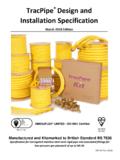Transcription of Safety changes in the industrial and commercial use of LPG ...
1 Page 1 of 13 Safety changes in the industrial and commercial use of LPG: 2009-2015 A report by: uklpg - Trade association for the LPG industry in the UK and HSE Health and Safety regulator in GB Page 2 of 13 Executive Summary On the 11 May 2004 an explosion at Grovepark Mills, owned by ICL group in Glasgow, killed nine people and seriously injured 33 more. The incident was caused by the ignition of leaking liquefied petroleum gas (LPG) vapour and was subject of a public inquiry chaired by Lord Gill who recommended: A risk based LPG pipework replacement programme Development of a new Safety regime for the industry Improved communication and clarification of responsibilities Following the incident and subsequent Inquiry, HSE and the LPG supply industry worked together to develop a risk based plan to identify and replace all the high risk LPG pipework and further improve safe use of LPG.
2 At the core of this pipework replacement plan was the fact that service pipework is usually owned by the LPG customer not the supplier. Consequently, action on pipework replacement required involvement of LPG suppliers ( uklpg members), users and the relevant enforcing authorities. Initially 60,000 sites were identified where LPG was used as a fuel in industrial or commercial enterprises. These were surveyed and risk ranked to develop a high level replacement plan that aimed to replace the highest priority pipework by December 2013 and all other metallic pipework by the end of 2015. The work involved developing an industry training programme to increase the number of pipework fitters, and training and up-skilling of regulatory inspectors.
3 The December 2013 target was almost achieved, with only a relatively small number of unresponsive or difficult customers having to be chased the following year. This high priority phase involved more than 5,700 regulatory inspection visits, resulting in at least 2,330 improvement and 50 prohibition notices being issued. In addition, LPG suppliers visited more than 3600 sites in order to carry out site inspections and or remedial work where necessary. In 2011, the HSE appointed an Independent Expert Working Group (IEWG) to review progress and advise on the replacement timescale for the low priority premises. The IEWG categorised the low priority risk pipework into four risk groups (p 1 to 4) and came to a view that replacing all by the end of 2015 was not justifiable in terms of additional costs and resource implications.
4 Its conclusions were agreed and accepted by the industry and regulator and meant that priority 1 (p1) low risk pipework was planned to be replaced by end of 2015 with longer deadlines given for even lower risk pipework. LPG suppliers completed work at approximately 4,500 p1 sites by the end of 2015, a small number of resistant or difficult customers are being dealt with by the regulators. In addition to the LPG pipework replacement, that was part of the Inquiry recommendations and replacement plans, by December 2015 suppliers had completed remedial work at all high priority metered estates and caravan parks using LPG. Further, although not within HSE s regulatory responsibility and not part of the Inquiry recommendations, HSE and uklpg have worked together to provide a tool for domestic customers, so they can assess their risks, and get LPG suppliers to adopt appropriate strategies towards domestic customers.
5 Alongside the work to replace pipework, there has been extensive research, information sharing and creation of systems to make users aware of risks and prevent future incidents. Page 3 of 13 As an outcome of the incident the LPG industry and its trade association, uklpg , have renewed their commitment to Safety at LPG installations. They have demonstrated leadership in the implementation of Lord Gill s recommendations and a continued drive to improve Safety at their customers LPG installations. Page 4 of 13 Contents page 1. Introduction 5 2. Pipework replacement programme 5 Planning and installation prioritisation 5 High priority pipework replacement 6 Lower priority pipework replacement 7 Metered estates and caravan parks 8 Domestic homes 9 3.
6 Additional actions 9 Industry communications 10 Customer communication 10 Installation Record 10 Web-based guidance and information 10 4. Current and future Safety 11 Lifespan of plastic pipes 11 Industry approach going forward 11 5. References 12 Page 5 of 13 1. Introduction On the 11 May 2004 an explosion at Grovepark Mills, owned by the ICL group in Glasgow killed nine people and seriously injured 33 more. The incident was caused by the ignition of liquefied petroleum gas (LPG) that had accumulated from a leaking corroded metallic service pipe. Following conclusion of a joint police- HSE investigation, a public inquiry was initiated chaired by Lord Gill, to establish and make public the full facts of the incident1.
7 Following publication of the Inquiry report in 2009, on-going actions were focused and developed in light of the Inquiry recommendations, subsequent consultation2, and the government response3. Notably areas where regulatory and industry actions were proposed included: A risk based LPG pipework replacement programme Development of a new Safety regime for the industry Improved communication and clarification of responsibilities This report, co-written by uklpg , the association of LPG suppliers, and HSE documents the response of the LPG industry and regulator to date. Emphasis is on efforts to replace higher risk service pipework but it provides an overall snapshot of the current health and Safety position of industrial and commercial LPG use in Britain.
8 2. Pipework replacement programme The critical and potentially most resource intensive recommendation by the Lord Gill Inquiry was the risk based pipework replacement programme that involved replacement of high risk metallic service pipework with polyethylene pipework. The duty for replacement fell on the owner of the service pipework who in most cases was the LPG user. However, LPG suppliers agreed to work with HSE to identify higher risk installations and assist in the replacement programme. This was overseen by a high level team of HSE and industry representatives that met regularly to oversee the progress on the replacement programme and other recommendations.
9 Action to achieve the inquiry recommendations on pipework replacement required involvement of uklpg members, LPG users and relevant enforcing authorities. Planning and installation prioritisation Understanding the extent of the issue, key risk factors and resources available to undertake a risk based replacement programme was necessary to deliver a sensible replacement plan. The HSE led a project to establish the risk ranking of all industrial and commercial (hence forth termed just commercial ) LPG installations, that included among other things a prioritisation survey of commercial users4 and use of a tailored computer model developed and applied by GL Noble Denton.
10 Concurrently the industry modelled resource requirements that considered LPG engineer resource constraints and seasonal effects in the industry. These were brought together in 2009 into a high-level plan agreed between HSE and uklpg for the replacement of buried metallic LPG service pipework across England, Scotland and Wales5. This plan confirmed that high risk pipework, that being carbon steel pipework in the most corrosive soils, should be targeted first. Such high risk pipework was scheduled for replacement by the end of 2013 and all other metallic pipework by the end of 2015. Page 6 of 13 At the core of the replacement programme is the fact that the service pipework is usually owned by the customer to whom the LPG distributor is supplying gas.
















